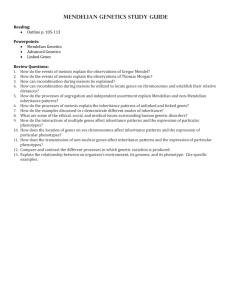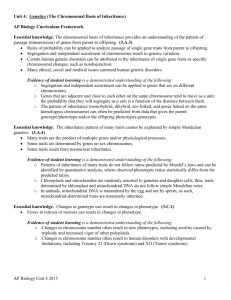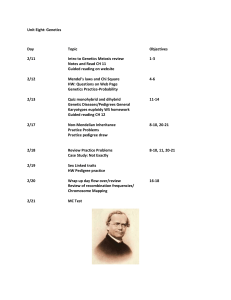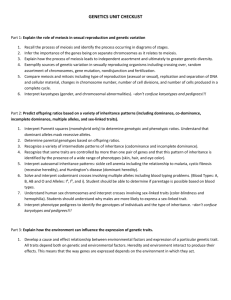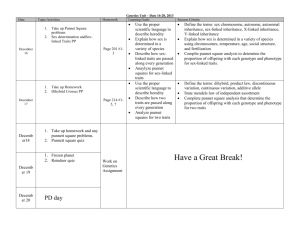Essential Questions
advertisement
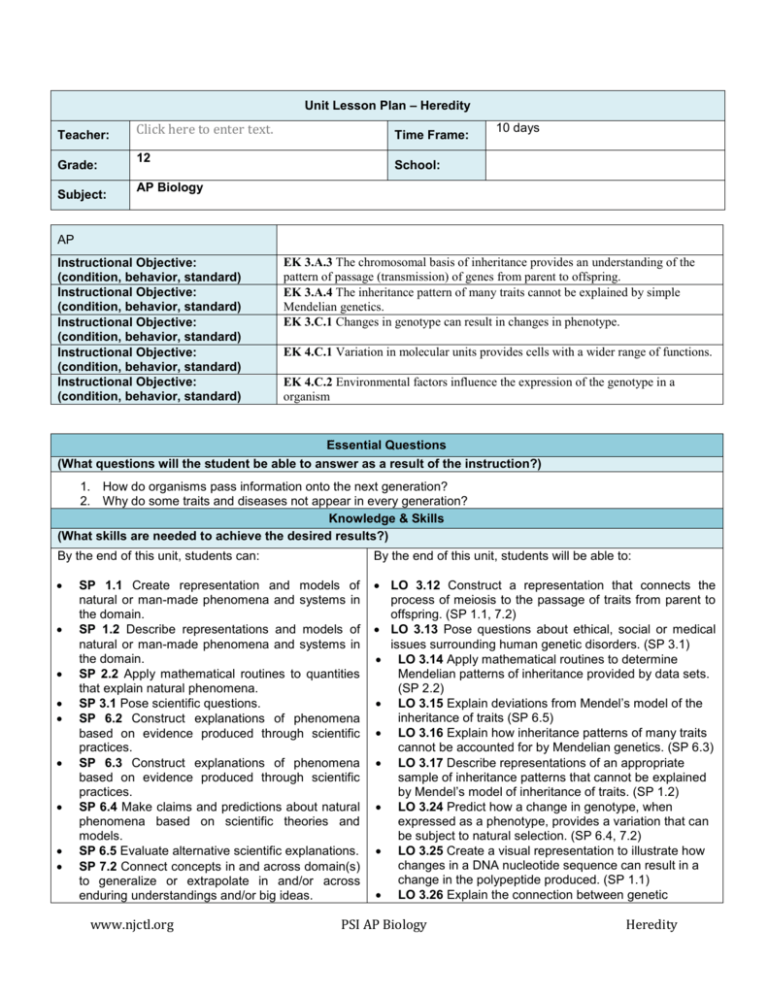
Unit Lesson Plan – Heredity Teacher: Grade: Subject: Click here to enter text. Time Frame: 12 10 days School: AP Biology AP Instructional Objective: (condition, behavior, standard) Instructional Objective: (condition, behavior, standard) Instructional Objective: (condition, behavior, standard) Instructional Objective: (condition, behavior, standard) Instructional Objective: (condition, behavior, standard) EK 3.A.3 The chromosomal basis of inheritance provides an understanding of the pattern of passage (transmission) of genes from parent to offspring. EK 3.A.4 The inheritance pattern of many traits cannot be explained by simple Mendelian genetics. EK 3.C.1 Changes in genotype can result in changes in phenotype. EK 4.C.1 Variation in molecular units provides cells with a wider range of functions. EK 4.C.2 Environmental factors influence the expression of the genotype in a organism Essential Questions (What questions will the student be able to answer as a result of the instruction?) 1. How do organisms pass information onto the next generation? 2. Why do some traits and diseases not appear in every generation? Knowledge & Skills (What skills are needed to achieve the desired results?) By the end of this unit, students can: By the end of this unit, students will be able to: LO 3.12 Construct a representation that connects the process of meiosis to the passage of traits from parent to offspring. (SP 1.1, 7.2) LO 3.13 Pose questions about ethical, social or medical issues surrounding human genetic disorders. (SP 3.1) LO 3.14 Apply mathematical routines to determine Mendelian patterns of inheritance provided by data sets. (SP 2.2) LO 3.15 Explain deviations from Mendel’s model of the inheritance of traits (SP 6.5) LO 3.16 Explain how inheritance patterns of many traits cannot be accounted for by Mendelian genetics. (SP 6.3) LO 3.17 Describe representations of an appropriate sample of inheritance patterns that cannot be explained by Mendel’s model of inheritance of traits. (SP 1.2) LO 3.24 Predict how a change in genotype, when expressed as a phenotype, provides a variation that can be subject to natural selection. (SP 6.4, 7.2) LO 3.25 Create a visual representation to illustrate how changes in a DNA nucleotide sequence can result in a change in the polypeptide produced. (SP 1.1) LO 3.26 Explain the connection between genetic SP 1.1 Create representation and models of natural or man-made phenomena and systems in the domain. SP 1.2 Describe representations and models of natural or man-made phenomena and systems in the domain. SP 2.2 Apply mathematical routines to quantities that explain natural phenomena. SP 3.1 Pose scientific questions. SP 6.2 Construct explanations of phenomena based on evidence produced through scientific practices. SP 6.3 Construct explanations of phenomena based on evidence produced through scientific practices. SP 6.4 Make claims and predictions about natural phenomena based on scientific theories and models. SP 6.5 Evaluate alternative scientific explanations. SP 7.2 Connect concepts in and across domain(s) to generalize or extrapolate in and/or across enduring understandings and/or big ideas. www.njctl.org PSI AP Biology Heredity variations in organisms and phenotypic variations in populations. (SP 7.2) LO 4.22 Construct explanations based on evidence of how variation in molecular units provides cells with a wider range of functions. (SP 6.2) LO 4.23 Construct explanations of the influence of environmental factors on the phenotype of an organism. (SP 6.2) LO 4.24 Predict the effects of a change in an environmental factor on the genotypic expression of the phenotype. (SP 6.4) Assessment (What is acceptable evidence to show desired results (rubrics, exam, etc.)? Attach Copy During the Smart Notebook lesson designed to introduce concepts, students will be continually questioned on these concepts using a combination of class work/homework questions and the SMART Response system. Classwork and Homework questions will be discussed as a class and misconceptions will be addressed by the teacher prior to the formal evaluations listed below. Formative Evaluations: Summative Evaluations: Artificial Selection Lab (begun during this unit) Meiosis & Independent Assortment Quiz Non Mendelian Inheritance Quiz Probability & Statistics Quiz Lab #1 Quiz (will likely occur after Unit Test depending on plant growth) Unit Test (What is the sequence of activities, learning experiences, etc, that will lead to desired results (the plan)? Topic Classwork 1 Artificial Selection Lab Prepare bee sticks for pollination (if necessary) 2 (lab) Artificial Selection Lab Steps 8-10: Pollination 3 Meiosis & Heredity SMART Notebook Slides 430; Questions #1-7 #12-19 4 Independent Assortment SMART Notebook Slides 31-68; Questions 8-11 #20-22 What Mendel Didn’t Know Quiz 1: Meiosis & Independent Assortment SMART Notebook Slides 69-113; Questions #23-31 #32-39 Day 5 www.njctl.org PSI AP Biology Homework Heredity 6 Genetic Disorders Quiz 2: Non-Mendelian Inheritance Genetic Counseling Activity Analysis Questions 7 Probability & Statistics SMART Notebook Slides 114-140; Questions #40-43 44-48 8 Review Quiz 3: Probability & Stats MC/FR MC/FR 9 Review MC/FR Study 10 Test Test www.njctl.org PSI AP Biology Heredity


